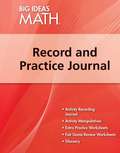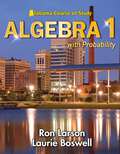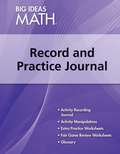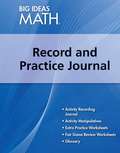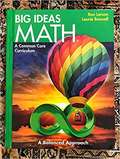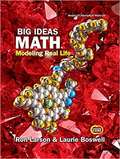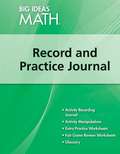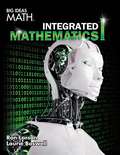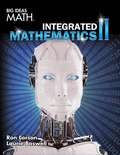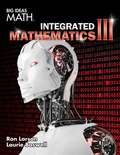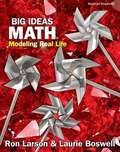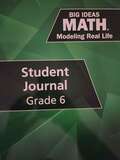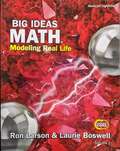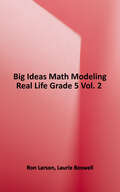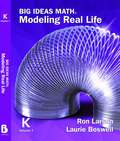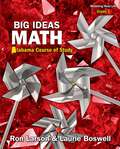- Table View
- List View
Big Ideas Math: A Common Core Curriculum, Red, Record and Practice Journal
by Ron Larson Laurie BoswellNIMAC-sourced textbook
Big Ideas Math: Algebra 1, A Common Core Curriculum, Record And Practice Journal
by Ron Larson Laurie BoswellNIMAC-sourced textbook
Big Ideas Math: Blue, A Common Core Curriculum, Record And Practice Journal
by Ron Larson Laurie BoswellNIMAC-sourced textbook
Big Ideas Math: Common Core Curriculum Green
by Houghton Mifflin Harcourt Publishing Company StaffConsistent with the philosophy of the Common Core State Standards and Standards for Mathematical Practice, the Big Ideas Math Student Edition provides students with diverse opportunities to develop problem-solving and communication skills through deductive reasoning and exploration. Students gain a deeper understanding of math concepts by narrowing their focus to fewer topics at each grade level. Students master content through inductive reasoning opportunities, engaging activities that provide deeper understanding, concise, stepped-out examples, rich, thought-provoking exercises, and a continual building on what has previously been taught.
Big Ideas Math: Common Core Grade 7
by Ron LarsonConsistent with the philosophy of the Common Core State Standards and Standards for Mathematical Practice the Big Ideas Math: Modeling Real Life Student Edition features several components to help position students for success and keep them on the right track for mathematical proficiency. The Big Ideas Math Student Edition provides students with learning targets and success criteria at the chapter and lesson level to make learning visible. Diverse opportunities to develop problem-solving and communication skills through deductive reasoning and exploration are also prominent throughout the text. Students gain a deeper understanding of math concepts by narrowing their focus to fewer topics at each grade level. Students master content through inductive reasoning opportunities, engaging activities that provide deeper understanding, concise, stepped-out examples, rich, thought-provoking exercises, and building connections to previous skills for coherence.
Big Ideas Math: Common Core Student Edition Red 2014
by Houghton Mifflin Harcourt Publishing Company StaffBig Ideas Math: Common Core Student Edition Red 2014 - Math Textbook
Big Ideas Math: Green, A Common Core Curriculum , Record And Practice Journal
by Ron Larson Laurie BoswellNIMAC-sourced textbook
Big Ideas Math: Modeling Real Life - Grade 1 Volume 1
by Ron Larson Laurie BoswellNIMAC-sourced textbook
Big Ideas Math: Modeling Real Life - Grade 6 Student Journal (1-Year)
by Ron LarsonThis student-friendly, all-in-one, consumable workbook contains Review & Refresh, Exploration Journal, Practice Worksheets, Notetaking with Vocabulary, Self-Assessment, and Exploration Manipulatives.
Big Ideas Math: Modeling Real Life Common Core - Grade 4 Volume 2 (1-year)
by Ron LarsonThe Big Ideas Math: Modeling Real Life Student Edition Volume 2 is a 4-color consumable worktext that features several components to help position children for success and keep them on the right track for mathematical proficiency. The Big Ideas Math: Modeling Real Life Student Edition Volume 1 provides students with learning targets and success criteria at the chapter and lesson level to make learning visible. There are diverse opportunities to develop problem-solving and communication skills through the balanced instructional design of Explore and Grow, Think and Grow, Apply and Grow, and Think and Grow: Modeling Real Life. Students master content, skills, and embedded mathematical practices through engaging activities with opportunities to enhance with games, songs, literature-based exercises that connect mathematics to the real world in an idea context for elementary students. Volume 2 is intended for for approximately the second half of the school year. Volume 2 is the second volume in a 2-volume Student Edition set.
Big Ideas Math: Modeling Real Life Common Core - Grade 8
by Ron LarsonConsistent with the philosophy of the Common Core State Standards and Standards for Mathematical Practice the Big Ideas Math: Modeling Real Life Student Edition features several components to help position students for success and keep them on the right track for mathematical proficiency. The Big Ideas Math Student Edition provides students with learning targets and success criteria at the chapter and lesson level to make learning visible. Diverse opportunities to develop problem-solving and communication skills through deductive reasoning and exploration are also prominent throughout the text. Students gain a deeper understanding of math concepts by narrowing their focus to fewer topics at each grade level. Students master content through inductive reasoning opportunities, engaging activities that provide deeper understanding, concise, stepped-out examples, rich, thought-provoking exercises, and building connections to previous skills for coherence.
Big Ideas Math: Modeling Real Life Common Core, Grade 5, Student Edition, Volume 2 (1-year)
by Ron Larson Laurie BoswellNIMAC-sourced textbook
Big Ideas Math: Modeling Real Life Grade K
by Ron Larson Laurie BoswellBig Ideas Math®: Modeling Real Life. Written by renowned authors Dr. Ron Larson and Dr. Laurie Boswell, this series uses an exploratory approach to engage students’ inquiring minds through rich explorations and in-class problem solving. With one voice from Grade K through Grade 8, students make connections through cohesive progressions and consistent, dependable instruction.
Big Ideas Math: Modeling Real Life, Grade 1, Volume 1
by Ron Larson Laurie BoswellNIMAC-sourced textbook
